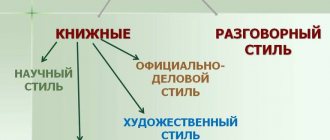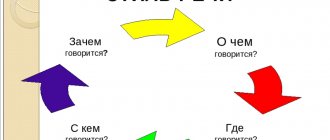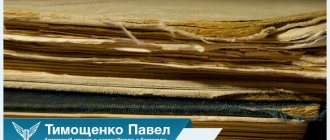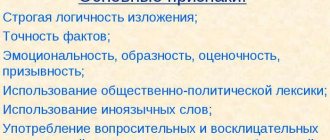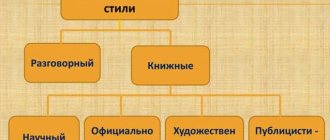In the modern Russian literary language, there are 5 functional styles of speech: colloquial, journalistic, official business, artistic and scientific style of speech.
In this article we will analyze in detail the scientific style of speech. You will find answers to the following questions:
- what is scientific style of speech;
- its main function and tasks;
- scope of application;
- features and characteristics of the scientific style;
- substyles or varieties;
- genres of scientific style of speech;
- example of a scientific text.
What is the scientific style of speech, its functions and tasks
The scientific style of speech is a functional style of speech of the Russian literary language, which is a means of communication in the field of scientific, scientific-professional and educational-scientific activities.
The main function of the scientific style of speech is informative. It consists in conveying objective information about man, nature, and society.
The task of the scientific style is to explain natural and social phenomena, identify patterns and identify cause-and-effect relationships.
Scientific style texts are distinguished by clarity, logic, accuracy, objectivity and evidence-based presentation of information.
And finally - two useful tips
Read more scientific literature . By reading scientific literature, you not only study your subject, but also acquire scientific style. Any writer (even if this writer is a scientist) is first and foremost a reader.
We also recommend: How to search for information for a scientific article
Try to write scientific texts . Reports, essays, coursework - for teachers this is a way to test your knowledge, and for you, writing such works is an excellent opportunity to master the scientific style in practice. And if you already have a supervisor, ask him to check your articles not only from the point of view of compliance with the scientific specifics, but also from the point of view of style.
Scope of application of scientific style
The scope of application of the scientific style of speech is the field of science and educational and scientific activity.
First of all, it is used in written form of speech: textbooks, articles, dissertations, reports, encyclopedias, etc. But it is also found in oral form (for example, during scientific conferences).
To design presentations, printed materials, and publications, I recommend using Canva. This is a very simple and convenient all-in-one visual editor. With thousands of professional templates, images, and other quality elements, you'll get a great starting point to bring your best ideas to life.
Explaining Science: A Guide for Nonfiction Writers
Igor Ivanov, a theoretical physicist and an active popularizer of physics, tells what to focus on when writing popular science news, how to structure the text, how to select wording, how to work with sources and with your own text, how and why to “maintain” the news after its publication .
Explaining Science: A Guide for Nonfiction Writers
Igor Ivanov
Main features and characteristics of the scientific style of speech
The features and characteristics of the scientific style include:
- Logical presentation - information is presented consistently and in a clear sequence.
- Generality, accuracy and objectivity in the presentation of information.
- Evidentiary and rich presentation (many arguments, facts).
- Application of terms and general scientific words. On average, terms occupy about 15-20% of the total text volume.
- The use of words with an abstract meaning (these are words that do not evoke specific images in the mind and memory, for example: property, essence, worldview, reality).
- Most often there is a monologue character of speech.
- More nouns and adjectives, and a minimum of verbs.
- Complex sentence construction.
- The sentences are mostly long.
- Practically no means of expression are used (epithets, comparisons, metaphors, etc.) and there is no expressive-emotional vocabulary (admirable, son, inspire, despise, sycophant).
- Correct word order.
- Strict sequence of presentation.
Scientific style of speech: its varieties or substyles
Like other styles of speech, the scientific style is rarely found in its “pure” form. Scientific texts may contain elements of both journalistic and official business style of speech.
Because of this interaction with other styles of speech, and depending on the purpose and specific application, the scientific style is divided into 6 substyles :
- Proper scientific or academic: dissertations, reports, communications, monographs, speeches;
- Educational and scientific: textbooks, lecture courses, course work, seminar report;
- Popular science: popular science books and magazines, children's encyclopedias;
- Scientific and informative: abstracts, reviews, summaries, theses;
- Scientific reference: encyclopedias, dictionaries, reference books;
- Scientific and technical: patents, standards, descriptions of inventions, specifications, technical conditions.
| Substyle name | Target | Genres |
| Actually scientific | Definition and description of new phenomena, facts, patterns. | dissertations, reports, communications, monographs, speeches, scientific articles. |
| Educational and scientific | Transferring scientific information to students, teaching, describing the facts necessary for mastering and mastering the material. | textbooks, lecture courses, course work, seminar report, notes, oral response. |
| Popular science | Familiarization with facts and phenomena. | popular science books and magazines, children's encyclopedias, articles. |
| Scientific and informative | Transmission of scientific information with a description of scientific facts. | abstracts, reviews, theses. |
| Scientific reference | Providing the reader with the ability to quickly find the necessary scientific information. | encyclopedias, dictionaries, reference books. |
| Scientific and technical | Application of scientific achievements in practice. | patents, standards, descriptions of inventions, specifications, technical conditions. |
Substyles (varieties) of scientific style of speech and examples of genres
Step 1: what is actually being stated here?
Any explanation of complex material, be it a school lesson or a scientific publication, begins with the formulation of a certain statement, which is then explained, proven, and illustrated with examples. Therefore, the first level of understanding is when the reader realizes what is actually being asserted here. And situations of complete misunderstanding often come down to the fact that a person simply does not grasp the very essence of the statements, and hears something other than what they are trying to convey to him.
For example, a popular question is: “Why can’t you divide by zero?” - a typical example of a misunderstanding of the statement itself left over from school.
A person thinks that he is forbidden to divide, forbidden to take one extra step and further determine the division process. He demands to be allowed and asks what the answer will be. But the real statement is completely different: any one-step additional definition will lead to an internally contradictory construction. You cannot assign the result of the operation 1/0 to any real number, because then you would violate the multiplication axioms established for all real numbers. You can designate the result with a new word "infinity", but this is only the first step. After all, next you will need to introduce rules for working with this infinity, which will differ from the rules for working with ordinary numbers, determine what equals infinity multiplied by zero, and decide how many “infinities” you will enter. No matter how you twist it, you will end up with a new number system with its own strange rules. It is this fact that is expressed by the phrase “you cannot divide by zero.”
Here’s an example from an academic environment: a person gives a report, and the entire audience looks at the slides with an unblinking, dazed gaze in complete silence. If you pull the listener out in this state and ask him to immediately say something about any of the slides, then after several minutes of torment he will begin to ask: what is this letter? what is this term? Where does this formula even come from? Here we have a classic example of a person - and perhaps the entire audience - not understanding what is being said at all. Let me emphasize that the problem here is not that the presentation is boring. The listener tries to follow the presentation, but if he missed something important from the very first minutes, he may completely cease to understand what is being said.
I am convinced that the first level of understanding is available to the interested listener on any scientific topic. He may not know the terminology or understand the technical details, but if you formulate in clear, simple words what was essentially done here, he will understand it.
Therefore, any popular science text should strive to convey to its readers the main idea at least at this first level of understanding. If the typical reader, a representative of the target audience, does not understand what it is about at all, the mission of the news will fail, no matter how smart the text itself may sound.
Here, for example, is a paragraph from a very short news story written in complex language:
“It turned out that in such a system it is impossible to obtain a completely conducting state in which single Dirac points would appear (the reason is again symmetry). However, such materials may be topological insulators or Weyl phases. The first are characterized by the fact that they have a conducting surface, but remain insulators in the bulk, and in the second, conducting quasiparticles arise that behave as if they have no mass.”
Do you understand right away what is possible, what is impossible and why? This paragraph will, of course, be clear to a specialist in condensed matter physics, but not to a non-specialist reader. In this paragraph there is such a high concentration of terms per line of text; they are introduced so quickly and with such meager explanations that the reader is simply unable to digest them.
Genres of scientific style of speech
Genres of scientific style are types of scientific texts that differ in their structure and functions.
There are several classifications of genres of scientific style. For example: primary and secondary scientific works or genres with free (articles, reviews) and with a fixed writing structure (dissertation).
In this article we will consider the classification of genres depending on the specific communicative and information functions that they perform.
Scientific style of speech: genres of the scientific substyle
The main function of this substyle is to identify and describe original research results, to present new facts, phenomena and patterns.
Genres of the scientific sub-style include:
- A monograph is a scientific study devoted to one specific phenomenon, fact, issue or topic. The volume of the classic text of the monograph is more than 120 pages in A4 format. This is a full-fledged scientific work.
- A scientific article is a short essay in which the author describes the results of his own research.
- A dissertation is a qualifying work, the successful completion of which is necessary for the award of an academic degree. Volume: from 50 to 500 pages. Available in the form of a book or bound manuscript.
Genres of this substyle also include reports, messages, and speeches.
Texts of the proper scientific substyle have a general writing structure, which includes:
- Name.
- Introduction.
- Main part.
- Conclusion.
Genres of educational and scientific substyle
Educational and scientific speech is used in the learning process, namely for the transmission and development of scientific information by students.
There are oral and written genres of educational and scientific substyle. Oral ones include: message and response .
The main written genres of this substyle are:
- A report is a detailed message on a specific issue, based on documentary data. The purpose of the report is to inform and provide recommendations or suggestions.
- A textbook is a teaching tool designed to assimilate, deepen and expand knowledge.
- Note - a summary or brief recording of a lesson, lecture, article.
- A course of lectures is a collection of lecture texts by one or more authors on individual topics or on the course as a whole. Covers the content of the academic discipline.
Popular science genres
This substyle is intended to disseminate scientific information among the mass recipient (for example, among a certain category of readers - children, teenagers, etc.).
Popular science genres include:
- Popular science books are literary works about science, scientists, scientific achievements and research, intended for a wide range of readers.
- Popular science magazines.
- Children's encyclopedias.
- Articles.
Genres of the scientific and information substyle
The function of the scientific information substyle is to convey scientific information.
The main genres of this substyle:
- An abstract is a short report on a specific topic, which collects information, most often from several sources.
- A review abstract is a report that compares different points of view on a particular issue. Compiled based on several sources.
- An abstract is a short report that outlines only the main points.
- The thesis is the leading genre of scientific style. It is a short record that outlines the main points of scientific research.
Genres of scientific reference substyle
The task of the scientific reference sub-style is to provide the reader with the ability to quickly find the necessary scientific information.
The main genres of the scientific reference substyle are:
- Encyclopedia is a scientific reference review of all or individual branches of knowledge in the form of a dictionary.
- A dictionary is a collection of words with their translation, interpretation and explanation.
- A reference book is a book that contains brief information of a scientific, social, industrial or applied nature.
- Catalog is a list of information about objects, the purpose of which is to facilitate the search for these objects by a certain criterion.
Scientific style of speech: genres of the scientific and technical substyle
The scientific and technical substyle is common in technical documentation. The texts of this substyle serve to apply in practice all the achievements that have been obtained as a result of theoretical and experimental scientific research.
The genres of the scientific and technical substyle include:
- A patent is a document certifying the exclusive right to an invention, product or process.
- Specification is a definition and list of specific features, a refined classification of something.
- Technical specifications are a document establishing the technical requirements that a specific product, material, substance, etc., or a group of them must meet.
- Standards.
- Description of inventions.
Examples of text analysis of different styles
return to the “Tables” page to the “Speech styles in the table” page, “Stylistic analysis”
ANALYSIS OF THE TEXT OF AN ARTISTIC STYLE
Song
(1) In the middle of the room stood Yashka the Turk, a thin and slender man of about twenty-three, dressed in a long-skirted blue nankeen caftan. (2) His sunken cheeks, large, restless gray eyes, a straight nose with thin, mobile nostrils, a white sloping forehead with light brown curls thrown back, large but beautiful, expressive lips - his whole face revealed an impressionable and passionate man. (3) He was in great excitement: he blinked his eyes, breathed nervously, his hands trembled as if in a fever... (4) Yakov paused, looked around and covered himself with his hand. (5) He took a deep breath and sang... (6) The first sound of his voice was weak and uneven and, it seemed, did not come out of his chest, but came from somewhere far away, as if it had accidentally flown into the room. (7) This sound was followed by another, more solid and drawn-out, but still apparently trembling like a string; followed by the second, the third, and, gradually warming up and expanding, a sad song began to pour out. (8) I admit, I have rarely heard such a voice: there was genuine deep passion, and youth, and strength, and sweetness, and some kind of captivatingly carefree, sad sorrow. (9) The Russian, truthful, hot soul breathed and sounded in him, and just grabbed you by the heart, grabbed you right by its Russian strings. (10) He sang, and from every sound of his voice you smelled something familiar and vastly wide, as if the familiar steppe was opening up before you, going into an endless distance. (I.S. Turgenev)
BEGINNING : The works of I. S. Turgenev depict the mystery of the human soul; the soul of a peasant who, despite the harsh serfdom, retained generosity, openness, and love of freedom. The depth of the soul, genuineness, sincerity, and desire for will are also revealed in Russian folk songs.
The main theme of this text, indicated in the title, is song. She is subordinated to 6 microthemes : 1) singer Yashka the Turk; 2) the singer’s facial features; 3) first sound; 4) the song flowed; 5) deep passion and hot soul in Yashka’s song; 6) in the song - infinity.
The author raises the problem of aesthetics. He is concerned about the expression of the soul of the people through art - music. The hero of the text, a native of the people, skillfully reveals the life of the Russian people like no other. The musical, impressionable Yashka the Turk is sensitive to the performance of the song - his whole soul is in it, so in his voice the narrator hears “genuine deep passion”, and youth, and strength, and sweetness... and sorrow.” Turgenev leads us to the idea that talent lives among the people, despite serfdom, and nothing can kill the love of freedom and space.
The text proposed for analysis, taken from a work of art , is a description of the subject . Why do we think so? The author, depicting the hero, pays attention to age, clothing, facial features, determines the nature of sounds, voices, songs. The writer also notes Yashka’s state of mind (“he was in great excitement: he blinked his eyes...”).
Fragments of the text are a narrative , which talks about actions that replace each other (“paused – looked – closed – sighed – sang”).
The sentences in the text are connected by a chain link , here there is a replacement of a noun with a personal pronoun (the sound is behind this sound). Admiring what he saw and heard, Turgenev creates a figurative, emotional picture, which is achieved by using various linguistic means: metaphor (“the song began to pour out, heated and expanding”), simile (“as if in a fever,” “as if he accidentally flew into the room”), epithet ( “expressive lips”), gradations (“sad grief”, “immensely wide”).
Ivan Sergeevich, describing the performer of the song, expresses his attitude towards him, calls him “an impressionable and passionate person” - these character traits help the singer convey the mood of the song, its depth. The author compares Yashka’s song with an endless distance, as if it absorbs the vastness of the fields and steppes of the Russian land, conveying the sound of the strings of the soul of a Russian person. The song comes from afar, the “Russian, truthful, ardent soul” sounds in it, and this song, connecting the past and present of the people, goes into the distance, into the future.
Thus , a folk song is truly a reflection of the life of the people. It contains his pain, and joy, and love, and suffering, and hope. In it lies his strength and immortality.
ANALYSIS OF TEXTS OF JOURNALISTIC STYLE
(1) “Everything, O Lucilius, is not ours, but someone else’s, only time is our property. (2) Nature has placed in our possession only this ever-flowing and impermanent thing, which, in addition, can be taken away from us by anyone who wants it... (3) People absolutely do not value other people’s time at all, although it is the only thing that cannot be return it back if you wish.” (4) This is what Seneca wrote at the very beginning of our era, in 50 A.D. (5) The ancient philosophers were the first to understand the value of time - they probably even before Seneca tried to somehow curb time, tame it, understand its nature, for then it was depressing with its transience. (6) However, due to our conceit, we are sure that the ancients had nowhere to go. (7) That they, with their sun, water and hourglasses, did not know how to measure it properly, and therefore did not take care of it. (8) Progress - after all, it comes down to this, in the opinion of a business person, to save this business person time. (9) To do this, the business man moved from the carriage to the train, and from there to the plane. (10) Instead of letters, they came up with telegrams and telephones, instead of theaters - televisions, instead of a quill pen - a ballpoint pen. (11) Escalators, computers, department stores, teletypes, electric shavers - everything is invented in order to save a person’s time. (12) However, for some reason, a person’s lack of this time is increasing. (13) A business person increases speed, introduces computers, converts department stores into department stores, prints newspapers using the photo method, and time pressure increases. (14) Not only for him - time pressure becomes universal. (15) There is not enough time for friends, there is no time for children to think, to stand without thinking in the autumn forest, listening to the crunch of flying leaves. (16) Neither schoolchildren, nor students, nor the elderly have time. (17) Time disappears somewhere, it becomes less and less. (D. Granin)
BEGINNING: Do we always value other people’s, and our own, time? And why should you save time? What do we do to save it? We will think about these questions together with the author of the text, D. Granin. ( Another option: How did the ancients relate to time? How did people try to curb time? Did modern man solve the problem of time pressure? This is discussed in the text by D. Granin).
The leading theme of this text is thinking about the lack of time. Three micro-themes are subordinate to it : 1) Seneca on time; 2) an attempt by the ancients to curb time; 3) the desire to solve the problem of lack of time. D. Granin is concerned about the issue of time shortage. He argues that you need to value time, your own and other people’s, because it “cannot be returned back.” The author leads us to the idea that with the enormous busyness of modern man, the inability to organize time can deprive him of the opportunity to come into contact with the world of beauty and enrich his inner world.
The analyzed text belongs to the journalistic style . What does this say? The text draws attention to the socially significant problem of lack of time. It is characterized by logic, imagery, emotionality, and evaluativeness.
Type of text - reasoning . Why do I think this? 1) The thesis is contained in sentence 3: “Time is the only thing that cannot be returned back no matter how hard you want.” 2) as proof . 3) The conclusion is contained in sentences 14-17.
The sentences in the text are connected by chain and parallel connections . What does this indicate? Thus, sentences 6-7 are connected by replacing the noun “among the ancients” with the pronoun “they”; the pronoun “for this purpose” in sentence 9 replaces part of the statement in sentence 7: “to save this business person time”; sentences 13 and 14 – by replacing the phrase “lack of time” with the word “ceyton” and the noun “business person” with the pronoun “he”. Sentences 15-17 are related in meaning.
The text proposed for analysis contains linguistic means characteristic of the journalistic style . What role do they play? Quoting helps D. Granin convince the reader of the significance of the issue raised; introductory words (“and therefore,” “in the opinion of a business person”) express the speaker’s attitude to what is being expressed; for the sake of homogeneous members (“to curb, tame, understand,” “increases, introduces, remodels”) create expressive semantic correlation; gradation (“neither among schoolchildren, nor among students, nor among old people”) “strengthens” the impression.
Thus , indeed, time pressure in our time is becoming universal. The lack of time is especially noticeable in a big city. People have no time to admire the beauty of nature, go to a museum, theater, chat with friends, or read an interesting book. A person turns into a robot and forgets about spiritual development.
ANALYSIS OF TEXT OF POPULAR SCIENTIFIC STYLE
(1) The mystery of blood circulation was revealed only in the century after numerous experiments on animals and the study of anatomy on human corpses. (2) It turned out that blood is not consumed in the organs, but only passes into them from arteries to veins through the smallest vessels - capillaries - and returns to the heart. (3) Thus, the closed nature of its movement throughout the body was established. (4) If we talk about a person, then on average during his life the lungs make 720 million inhalations and exhalations, and the heart makes three billion beats. (5) What a motor! (6) It is difficult to even compare this biological machine with something created by people. (7) This is why it has proven difficult to create an artificial heart. (8) Unfortunately, this task is very important, since the human heart often fails without exhausting the resources allotted to it by nature. (9) Now we are not talking about the problem of heart transplantation from a doctor. (10) We are talking only about artificial devices. (11) There has been some success here; many patients live with artificial heart valves. (12) But these operations are still very expensive, and there is also the problem of rejection of substances foreign to our body. (13) Research in this area is going on very intensively; there is enough work here for bionics (Children's Encyclopedia “I Explore the World”).
BEGINNING: How was the pattern of blood movement throughout the body established? Why not just create an artificial heart? What is the disadvantage of an artificial heart? This is stated in the text from the encyclopedia.
The leading theme of this text is a story about the work of the heart. Three micro-themes are subordinated to it : 1) discovery of the secrets of blood circulation; 2) the difficulty of creating an artificial heart; 3) “pros” and “cons” in the use of artificial heart valves.
This text raises the scientific problem of studying the work of the heart and the use of an artificial device.
The text belongs to the scientific style ; this is one of its substyles - popular science . Why do I think this? Here there are typical signs of a scientific style: logical presentation, accuracy, generalization, objectivity. Scientific judgments are written in accessible, clear, understandable language, explained in detail, and illustrated with examples.
The analyzed text belongs to the reasoning text . What does this say? It contains reflection on the issues raised in the text; there are sentences that are a kind of conclusion arising from the facts (sentence 3, 7).
Sentences in encyclopedia text are predominantly connected by chain links . What does this indicate? So sentences 1 and 2 are connected using the same root words “blood circulation” - “blood”; sentences 2 and 3 – by replacing the noun “blood” with the pronoun “her” and using the adverb “so” in sentence 3, replacing the statement in the previous one, the word “motor” in sentence 5 is a contextual synonym for the word “heart” in sentence 4.
The text contains language means characteristic of the scientific style, popular science substyle . What is their role? The use of terms (“blood circulation”, “arteries”, “vein”, “artificial heart”, “bionics”), phrases “noun. + noun in genus P." (“study of anatomy”, “problems of heart transplantation”, “problem of intrusion of substances”, abstract verbal nouns (“movements”, “transplants”, “searches”) emphasizes strict consistency, semantic accuracy, and reliability.
The use of exclamatory sentences , periphrases (“motor”, “biological machine”), introductory words (“unfortunately”), modal particles (“only”, “even”) simplifies the language of science, draws attention to the scientific problem raised and makes the text accessible for a wide range of readers.
Thus , this text attracts me with interesting facts from the field of medicine. It gives me pride in a person who has gone far in studying the work of the heart, and instills faith in me that in the distant future, human life expectancy will increase.
ANALYSIS OF SCIENTIFIC TEXT
On the issue of speech culture of foreigners
(1) The Russian language for foreign students is one of the linguistic disciplines, which equally involves both teaching the language, introducing into the student’s mind the idea of language as a system, and mastering the ethical side of the use of linguistic means in speech. (2) The teacher’s tasks, along with practicing the grammatical correctness of speech, include showing the appropriateness and ethics of using certain speech means and the specifics of their stylistic functioning. (3) The purpose of updating such knowledge and training on speech culture in a foreign audience is to create a comfortable communication environment for a foreign student, to satisfy the linguistic and other intellectual needs of the individual. (4) In this regard, taking into account the peculiarities of the mentality of students and the mentality of the Russian nation, preaching tolerance and goodwill in communication, at the advanced stage of training foreigners, special attention should be paid to the culture of speech as a syncretic discipline reflecting the linguistic, ethical, psychological, aesthetic aspects of communication.
(5) The sphere of communication of a foreigner is not limited only to professional interests. (6) In conditions of diversity of speech contacts, the achievement of a communicative goal in a specific situation is carried out thanks to the conscious (and sometimes unconscious) choice of speech means that, from the point of view of the speaker, optimize communication with native speakers. (7) A foreigner, who does not feel very confident in a foreign language environment, chooses short language formulas (often they are phonetically consonant with phrases of his native language), which would allow him to solve a communicative task: establish contact, have a positive attitude towards further communication, express a thought. (8) At the same time, sometimes a foreigner’s interlocutors – in particular, teachers – have to deal with violations of appropriateness and etiquette norms in his speech. (9) So, for example, to the question What is the ending in this case form? the Hindu student replied: Who knows! (10) It can be assumed that, in addition to the factor of not knowing the answer, this form of reaction was influenced by the brevity of the phrase and the desire to demonstrate “extended” language proficiency, not limited by the vocabulary of training sessions. (11) The Arabs, due to the significant graphic and phonetic differences of their language from Russian, also try to minimize speech means in both written and oral forms of transmitting information. (12) In particular, to establish contact during a meeting, they actively use the speech formula How are (your) doing? (13) In Russian-speaking audiences, this cliché is usually addressed from the teacher to the student, and not vice versa.
(14) So, we noticed that certain speech constructions are perceived by foreigners as ethically neutral, while in the Russian language they are characterized by peculiarities of stylistic functioning. (15) In this regard, due to insufficient cultural and speech competence in the conditions of a new language environment, the social characteristics of friend - stranger, younger - equal - elder, man - woman, often turn out to be irrelevant for foreigners. (16) Meanwhile, ethics is the most important component of communication, and teaching foreigners the culture of speech should be as mandatory as teaching the Russian language as a system.
(Larionova A. Yu. On the issue of the speech culture of foreigners // Linguocultural problems of tolerance: Abstracts of reports. International scientific conference (Ekaterinburg, October 24–26, 2001) Ekaterinburg: Ural State University Publishing House, 2001. With 243–244.)
- The text was created in a scientific style of speech ( academic substyle ).
- The genre of the text is the abstract of the report .
- Type of text - reasoning .
- The text refers to such a science as linguistics, to such a section as the culture of speech. The text is devoted to the problem of teaching foreigners the Russian language, namely, the need to teach them the norms of Russian speech etiquette.
- This text presents most of the stylistic features and linguistic features of the scientific style of speech.
5.1. The text is characterized by the accuracy of the presentation of information. This is achieved, firstly, through the use of special linguistic terms: language (1), linguistic means (1), speech (1), speech means (2), grammatical correctness (2), stylistic (2), speech culture ( 3), communicative goal (6), communicative task (7), language environment (7), lexicon (10), phonetic (11), written form, oral form (11), speech formula (12), cultural and speech competence (15); in addition, the words communication (3, 4, etc.), communication / communicative (5, 6, 16, etc.) are used, which can be considered interscientific (used in a number of humanities - linguistics, psychology, sociology).
Secondly, general scientific vocabulary is quite widely used: discipline (1), system (1), means (1), task (2), specificity (2), goal (3), sphere (3), stage (4), conditions (6), point of view (6), environment (7), formula (7), form (9), factor (10), design (14), feature (15).
Thirdly, the accuracy and coherence of the presentation of thoughts is achieved through the repetition of key words and phrases, which can be considered the following: teaching (language), speech culture, communication, communicative, linguistic (speech) means, ethical.
Fourthly, the accuracy and thoroughness of the presentation is facilitated by the presentation of factual data: to illustrate theoretical positions, the author uses examples of specific speech statements of foreign students (Who knows (9), How are you doing (12)).
5.2. The logical nature of the presentation is ensured by the active use of words and phrases that perform a connecting and formative function:
- to establish cause-and-effect relationships between phrases, the elements in connection with this (4), in virtue of (11), in this connection (15) are used;
- the function of comparing and contrasting parts of the text is performed by phrases both ... and (1, 11), the same as (16), along with (2), while (14), meanwhile (16);
— the meaning of the addition is formed using the element also (11);
— illustrations are introduced using words for example (9), in particular (12)
— the output value has the component so (14).
5.3. The text is fully characterized by the generality and abstractness of the information presented. At the language level, this is manifested, firstly, in the widespread use of nouns with abstract meaning; Wed words from paragraph 1: consciousness, system, correctness, appropriateness, ethics, specificity, peculiarity, tolerance, goodwill, mentality, etc.). In addition, the imperfective verbs used in the present tense form give a generalized, abstract character to the text; These are the vast majority of personal forms of the verb in the text: assumes (1), enters (2), is not limited (5), is carried out (6), chooses (7), tries (11), uses (12), is perceived (14 ), are characterized by (14), turn out to be (15). The exception here is the verb in the fragment of the text where the example is given (the Hindu student ... answered (9)); since in this case a specific individual situation is described, a departure from grammatical uniformity is justified and natural.
5.4. The text is characterized by restraint and severity of tone, unemotional presentation. The words used in the text have either a neutral (Russian language, foreign, teacher, comfortable, situation, contact, meeting, etc.) or a bookish (book-specific) stylistic connotation (student (1), syncretic (4), minimize (11), audience (13), competence (15), etc.). Reduced colloquial vocabulary, no jargon (exceptions are examples of student statements that are not components of the author’s text).
There are no emotional-evaluative lexical units in the text, however, words are used with which the author characterizes objects and phenomena, expressing a rational assessment: special (attention) (4), significant (differences) (11), actively (use) (12), insufficient (competence) (15), irrelevant (signs turn out to be) (15), most important (component of communication) (16).
There are practically no artistic means of expression in the text.
5.5. Despite the fact that in the text the author shares his own thoughts on the problem and presents the results of his own observations, the text, in accordance with the requirements of scientific stylistics, is characterized by a weak expression of the author’s personality . The construction [pronoun I + verb in personal form] is absent, but alternative grammatical structures are found:
— impersonal construction: should be given (special attention) (4);
- passive construction with the author's we: we noticed (14).
5.6. The text, in accordance with the characteristics of the academic substyle, is distinguished by grammatical complexity , which is manifested in a number of parameters.
Verbal nouns in -i/-nie and -iya/-tion are widely used (in terms of quantity in the text they significantly prevail over verbs): training (1), implementation (1), presentation (1), assimilation (1), use (1), use (2), functioning (2), presentation (3), knowledge (3), creation (3), communication (3), satisfaction (3), achievement (6), violation (8), ignorance (10), desire (10), reaction (10), possession (10), occupation (10), difference (11), establishment (12).
Participles and participial phrases are used quite actively: in discipline, reflecting the linguistic, ethical... aspects of communication (4); speech means that optimize... communication (6); a foreigner who does not feel very confident in a foreign language environment... (7); “extended” possession (10); language proficiency not limited to the vocabulary of classes (10);
There are adverbial phrases: taking into account the peculiarities of mentality... (4); preaching tolerance... (4).
There are verbs in the passive voice: the sphere... is not limited (5); achieving the goal... is carried out (6); designs are perceived (14).
A construction with a chain of words in the form of the genitive case is repeatedly used: assimilation of the ethical side (RP) of the use (RP) ... of linguistic means (RP) (1); showing the appropriateness (R.p.) and ethics (R.p.) of the use (R.p.) of certain speech means (R.p.) (2); creating for a foreign student (F.S.) a comfortable sphere of communication (R.S.) (3).
The complexity of the syntax is manifested in the fact that out of 16 sentences of the text, only four (5, 9, 12, 13) are short enough and do not have significant complicating structures. The remaining sentences are complicated by isolated definitions (for example, 4, 6, 7, 10), participial phrases (4), complementary, explanatory and clarifying constructions (for example, 2, 6, 7, 10, 11), chains of homogeneous members of the sentence (for example, 2, 3, 4, 7, 15) . Sentences 1, 7, 14 are complex.
Let's take a closer look at the sentences of one of the paragraphs, for example the first.
(1) The Russian language for foreign students is one of the linguistic disciplines, which equally involves both teaching the language, introducing into the student’s mind the idea of language as a system, and mastering the ethical side of the use of linguistic means in speech. – The sentence is long, complex, contains a couple of homogeneous members (both learning... and assimilation).
(2) The teacher’s tasks, along with practicing the grammatical correctness of speech, include showing the appropriateness and ethics of using certain speech means and the specifics of their stylistic functioning. – The sentence is complicated by a separate addition (along with practicing the grammatical correctness of speech) and a chain of homogeneous additions of 3 components (appropriateness and ethics... specificity).
(3) The purpose of updating such knowledge and training on speech culture in a foreign audience is to create a comfortable communication environment for a foreign student, to satisfy the linguistic and other intellectual needs of the individual. – The sentence is complicated by three pairs of homogeneous members of the sentence (knowledge, training; creation... satisfaction; linguistic and... intellectual).
(4) In this regard, taking into account the peculiarities of the mentality of students and the mentality of the Russian nation, preaching tolerance and goodwill in communication, at the advanced stage of training foreigners, special attention should be paid to the culture of speech as a syncretic discipline reflecting the linguistic, ethical, psychological, aesthetic aspects of communication. – The sentence is long, complicated by two homogeneous adverbial phrases (taking into account the peculiarities of the mentality of students and the mentality of the Russian nation, preaching tolerance and goodwill in communication); a separate definition with a chain of homogeneous members (reflecting the linguistic, ethical, psychological, aesthetic aspects of communication).
- Thus , most of the stylistic features and linguistic features (both lexical and grammatical) typical of the scientific style were found in this text. There are no facts in the text that would indicate a deviation from the stylistic norms of the language of science (colloquial, emotional and evaluative vocabulary, artistic means of expression, phraseological units, an abundance of short and uncomplicated sentences, etc.). Consequently, we can conclude that the speech work we analyzed fully complies with the stylistic requirements of a written scientific text created within the academic substyle.
ANALYSIS of the text of official business style
A household contract is concluded by placing an Order on a standard form established by the Contractor (ISNA LLC), one copy is issued to the Customer (citizen), and the second remains with the Contractor.
In accordance with the rules of consumer services for the population in the Russian Federation (approved by Decree of the Government of the Russian Federation of August 15, 1997 No. 1025), when drawing up an agreement for the performance of work on the manufacture of furniture, the Customer has the right to offer his drawing (sketch) of the product by filling out an addition to the Order or to use samples of furniture provided by the contractor. /Rules for performing furniture manufacturing work / Text analysis. This text refers to the official business style. Area of use: office work. Addressee – customer and contractor (organization that manufactures furniture). The purpose of the text is to inform citizens about the rules for making furniture. General properties of the text: prescriptive nature of the presentation, formality of tone, standardization of speech, accuracy (link to specific documents) Lexical features: -
use of clichés characteristic of a given style (these rules are established, a household contract, this agreement is a contract, is concluded by execution, etc.) d.) - the exact name of the institution, documents, abbreviations (ISNA LLC, Article 428 of the Civil Code of the Russian Federation, Government of the Russian Federation) - words are used in their direct meanings (agreement, form, contractor, customer, etc.)
Morphological features: -
predominance of nouns, including verbal ones (rules, contract, contract, execution, accession, service, etc.) - abundance of noun constructions.
+ noun R.p. (terms of the contract, when performing work, agreement of adhesion, etc.) -use of a denominate preposition ( by
formalization) -use of imperfect verbs (establish, is, is concluded, remains, etc.)
Syntactic features: -
simple, very common sentences (for example: “These rules establish the terms of the household contract (Article 730 of the Civil Code of the Russian Federation) when ISNA LLC performs work on the manufacture of furniture. This household contract is an adhesion agreement and is subject to the rules of Article 428 of the Civil Code of the Russian Federation") -complexity of syntax: isolation of different types. (“A domestic contract is concluded by placing an Order on a standard form established by the Contractor (ISNA LLC), one copy is issued to the Customer (citizen), and the second remains with the Contractor) - the text contains passive phrases (for example: “on the standard form forms established by the Contractor; approved by the Decree of the Government of the Russian Federation")
ANALYSIS OF CONVERSATIONAL STYLE TEXT
Hello, Sashka! I have amazing news! Just imagine, dad almost crashed his car yesterday. Do you remember that there was never a traffic light at the intersection near our house? Not even now. So, dad went to park the car in the garage through this stupid intersection. A number of them were allowed through. And suddenly some impudent foreign car drives out at speed from the right. He probably decided to avoid the traffic jam. Dad didn't expect this and didn't have time to stop. In general, everything ended well - they barely had time to turn around! Thank God, no one fell in love with anyone. Immediately, traffic cops appeared from somewhere and gave that crazy driver a fine. And he didn’t even apologize to dad – can you imagine?! Like this. Text analysis
.
This text is in a conversational style. Area of use: everyday communication. The addressee is a well-known person. The purpose of the text is to share information with the interlocutor. The text is characterized by emotionality and ease (it can be a phone call, or a conversation between friends). Lexical features:
- neutral vocabulary with a specific meaning predominates (news, yesterday, car, traffic light, intersection, garage, etc.) - there is colloquial, emotionally charged vocabulary that conveys the speaker’s attitude to what happened (dad, amazing, stupid, arrogant foreign car, traffic jam, barely, traffic cops, etc.)
Morphological features:
- evaluative adjectives and verbs (amazing, arrogant, abnormal, sniffed, etc.), - abundance of pronouns, interjections, particles (hello, for me, almost, our , thank God, even so)
Syntactic features:
- simplification of syntax (usually simple sentences, absence of participial and participial phrases), incomplete sentences (often as part of a complex sentence) For example: I have amazing news. Not even now. Dad didn’t expect this and didn’t have time to stop, etc. - one-part sentences: Can you imagine? Do you remember? A number of them were allowed through. - introductory words (probably) - there is an appeal to the interlocutor, talking about friendly relations (Sashka)
If you have any questions, ask in the discussions https://vk.com/board41801109 If you have mastered the topic, share with your friends. Test on the topic Types of texts Test on the topic Meaning of the text Test on the topic Types of speech Test on the topic Stylistics Test on the topic Functional styles of speech Tests on the topic Scientific style of speech Tests on the topic Publicistic style Tests on the topic Official business style Test on the topic artistic style Test on the topic Conversational style return to the “Tables” page to the “Speech styles in the table” page, “Stylistic analysis”
Structure of scientific text
Any scientific text, regardless of genre, is built according to a single logical scheme.
The basis is always a thesis - a statement that requires justification. To confirm and substantiate this thesis, the text must present argumentation and provide evidence . Often, for a more complete argument, illustrations - examples that confirm the scientific assumptions put forward.
The text ends with a conclusion or summary , which outlines an assessment of the research conducted and also presents prospects for further study.
Text tone
Errors in the tone of the text are probably more common in texts on humanities subjects. In any case, not only popular science, journalistic, critical, but even scientific publications in these disciplines very often contain value judgments expressed very biasedly. In addition, professional historians (or philologists) may profess and defend different political views. Of course, ideally, no political or, more broadly, ideological attitudes should influence scientific research. Scientificity should not be sacrificed for worldview. However, this is not always the case.
And young historians and philologists, reading the “passionate” books of their older colleagues, extract from them not only facts, but also the way they are presented - most often polemical (in this case, of course, we are not talking about the whole science, but only about the most characteristic samples of this kind, which at the same time turn out to be the most readable).
However, a scientific article should still be relatively neutral and operate with verifiable data that is not based on the author’s adherence to some narrow worldview. Of course, being scientific does not exclude polemics - however, this polemic must be conducted adequately, ethically and not go beyond the bounds of scientificity.
An example of texts written in a scientific style of speech
“A tornado is a strong small-scale vortex that arises in a thunderstorm (cumulonimbus) cloud and spreads in the form of a dark “trunk” towards the water or earth’s surface.
In the upper part, below the lower boundary of the cloud, the vortex has a funnel-shaped expansion. The barrel of a tornado descends to the earth's surface, its lower part, in contact with it, takes the form of an overturned funnel. The height of a tornado can reach 800–1500 m. The air in it rotates most often counterclockwise, rising in a spiral upward, drawing in dust or water, and fragments of objects destroyed on the ground.
The air rotation speed can reach 50–100 m/s with a strong upward component and cause catastrophes. destruction, sometimes accompanied by loss of life. At the same time, near his path there may be complete calm. Inside the tornado, the air pressure decreases, condensation of water vapor occurs there, which, together with the elongated part of the cloud, dust, water and decomposition. the debris makes death visible. Its axis is vertical, but often has a curved appearance.”
Electronic encyclopedia
» Existing territorial planning schemes for environmental management do not contribute to the creation of environmentally-oriented economic activities, which leads to conflict situations between economic entities both within the Kaliningrad region and outside it. Analysis of the features of socio-economic development and environmental policy made it possible to identify a number of significant methodological and methodological shortcomings in territorial planning and development. In particular, the development of the Kaliningrad region is carried out on the basis of poorly coordinated and poorly environmentally oriented departmental plans: urban planning, agricultural, reclamation, water, forest management, recreational and others.
Environmentally-oriented landscape planning can help in solving problems of territorial development. The landscape program of the Kaliningrad region is a strategic planning document for the use of the territory, forming an information and reference field for a wide range of organizations and officials responsible for the development and adoption of management territorial planning decisions, as well as state and non-state environmental and environmental funds, international organizations in the field of environmental control and management.
One of the most important tasks in implementing the program is the development of an integrated map of environmentally-oriented use of the territory and a map of environmental management conflicts. Solving these problems without the use of geographic information technologies is very complicated and sometimes impossible.”
Excerpt from the scientific article “Introduction of open geoinformation technologies into environmental planning methods”
Information sources:
- Russian language for technical universities. Scientific style. Author: Yu. Smirnova
- Wikipedia
- Russian language and culture of speech. Authors: Tatyana Balykhina, Mikhail Rybakov, Marina Lysyakova.
- Stylistics of scientific speech and editing of educational and methodological materials. A textbook for teachers and educators of the secondary education system.
- Photo on the cover of the article - science.sciencemag.org
PS: Did you like the article? Share the link on social networks, thank you!
Research level
The higher rungs of this ladder of levels of understanding already relate to research work. On them, a person is able to develop new knowledge himself. However, here too there is a gradation of levels of understanding.
Stage 4 is when you are able to generate understanding on your own. You can go further than you were told, you ask yourself questions and, overcoming technical difficulties, come to the answers. You not only see each step in the chain of arguments, but also understand what will happen if you change it. You can feel the limits of applicability of this chain.
Level 4 is, in general, the routine level of deep but technical immersion in the topic, the level of a good teacher of the subject. You can come up with new learning tasks, but all your ideas will remain within the standard picture and will be based on standard tools. But for fruitful scientific work, you need to rise one step higher - to where you begin to generate ideas, develop theories, and come up with new experimental setups. This doesn’t happen blindly, it doesn’t happen overkill, it’s the result of your accumulated experience in a certain area.
And finally, above all this there is the “epiphany mode” - the ability to make an unexpected leap of understanding that does not in any way follow from uniform research around the issue. Understanding at this level is when you, using either professional intuition or purposefully going beyond the boundaries of your task, suddenly find a non-trivial connection with some other, at first glance, extraneous statement. You formulate a completely new view of things - and numerous consequences immediately follow from it. To do this, a certain “voice” must sound in your head, asking very unexpected questions or offering to try something completely new.
If we return to Richard Feynman's phrase that no one really understands quantum mechanics, it becomes obvious that Feynman was talking about misunderstanding at the very top of the ladder.
Of course, physicists understand the technical aspects of quantum mechanics. But, speaking in the most general terms, physicists do not have a generally accepted understanding of why quantum mechanics should be implemented in our world at all, why our world cannot do without it, why other hypothetical forms of the fundamental laws of the microworld are not implemented.
Therefore, when you come across this Feynman quote as “proof” that quantum mechanics is incomprehensible, contradictory, incomprehensible to a normal person, know that the author giving the quote does not fully understand this statement. He probably does not understand it even at the level of the first step.
Book we recommend:
Igor Ivanov

